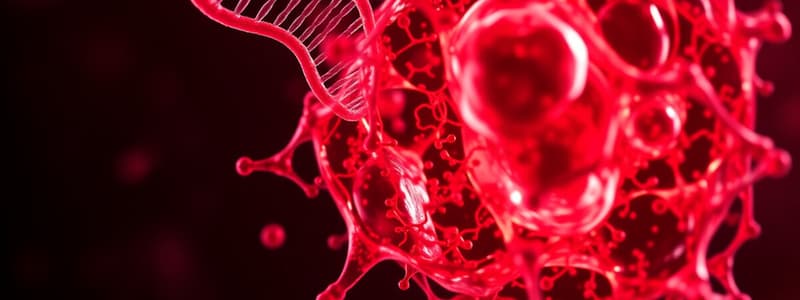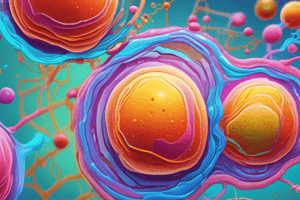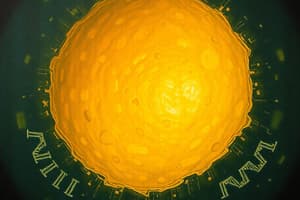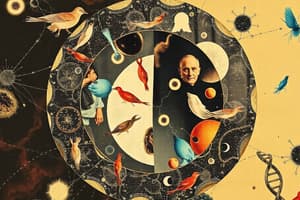Podcast
Questions and Answers
What is the primary role of the centromere during mitosis?
What is the primary role of the centromere during mitosis?
- To condense the chromosome structure
- To ensure correct distribution of duplicated chromosomes (correct)
- To protect chromosomes from degradation
- To create telomeres at the ends of chromosomes
How many chromosomes do human gametes contain?
How many chromosomes do human gametes contain?
- 46 chromosomes
- 22 chromosomes
- 44 chromosomes
- 23 chromosomes (correct)
What distinguishes the X and Y sex chromosomes from autosomes?
What distinguishes the X and Y sex chromosomes from autosomes?
- They are both homologous and identical
- They have the same information, shape, and size
- They behave as homologues but differ in information, shape, or size (correct)
- They have more chromosomes than autosomes
What is the structure of human telomeres primarily composed of?
What is the structure of human telomeres primarily composed of?
Which of the following best describes females in terms of gametic chromosomes?
Which of the following best describes females in terms of gametic chromosomes?
What function do telomeres serve in chromosomes?
What function do telomeres serve in chromosomes?
What is the role of shelterin in telomeric structure?
What is the role of shelterin in telomeric structure?
What feature characterizes sister chromatids?
What feature characterizes sister chromatids?
What is the primary role of telomerase in DNA replication?
What is the primary role of telomerase in DNA replication?
Which of the following statements about introns is true?
Which of the following statements about introns is true?
How many different proteins can the 21,000 human protein coding genes potentially produce due to alternative splicing?
How many different proteins can the 21,000 human protein coding genes potentially produce due to alternative splicing?
What is one of the main functions of regulatory sequences in the genome?
What is one of the main functions of regulatory sequences in the genome?
Which type of DNA is known for not encoding any protein, but may have regulatory functions?
Which type of DNA is known for not encoding any protein, but may have regulatory functions?
What is the typical nucleotide length of micro RNA (miRNA)?
What is the typical nucleotide length of micro RNA (miRNA)?
Which of the following best describes the concept of gene duplication?
Which of the following best describes the concept of gene duplication?
What defines a genome in the context of an organism?
What defines a genome in the context of an organism?
What is the main function of microRNAs (miRNAs) in the RNA-induced silencing complex (RISC)?
What is the main function of microRNAs (miRNAs) in the RNA-induced silencing complex (RISC)?
How many different mRNAs can a single microRNA target?
How many different mRNAs can a single microRNA target?
What is the role of long non-coding RNAs (lncRNAs) in gene expression?
What is the role of long non-coding RNAs (lncRNAs) in gene expression?
What is the primary structural component of the nuclear envelope?
What is the primary structural component of the nuclear envelope?
What is the main purpose of the nuclear pore complex?
What is the main purpose of the nuclear pore complex?
What is a characteristic of repetitive DNA sequences such as satellite DNA?
What is a characteristic of repetitive DNA sequences such as satellite DNA?
What is the function of the nuclear lamina?
What is the function of the nuclear lamina?
Which statement about the composition of genomic DNA in humans is accurate?
Which statement about the composition of genomic DNA in humans is accurate?
Which DNA polymerases are involved in the replication of nuclear DNA in eukaryotes?
Which DNA polymerases are involved in the replication of nuclear DNA in eukaryotes?
What is the direction of DNA synthesis by polymerases?
What is the direction of DNA synthesis by polymerases?
Why do eukaryotes require multiple origins of replication?
Why do eukaryotes require multiple origins of replication?
What initiates the process of DNA replication at the origins?
What initiates the process of DNA replication at the origins?
How does the replication of the E. coli genome differ from mammalian genomes?
How does the replication of the E. coli genome differ from mammalian genomes?
Which of the following statements is true regarding the forces involved in DNA replication?
Which of the following statements is true regarding the forces involved in DNA replication?
What role do single-stranded DNA-binding proteins play in DNA replication?
What role do single-stranded DNA-binding proteins play in DNA replication?
Which DNA polymerase is responsible for the replication of mitochondrial DNA?
Which DNA polymerase is responsible for the replication of mitochondrial DNA?
Where are chromosomes rich in genes typically located within the nucleus?
Where are chromosomes rich in genes typically located within the nucleus?
What effect does histone acetylation have on chromatin structure?
What effect does histone acetylation have on chromatin structure?
What is the role of histone acetyltransferase (HAT) in histone acetylation?
What is the role of histone acetyltransferase (HAT) in histone acetylation?
How does DNA methylation affect gene expression?
How does DNA methylation affect gene expression?
Which component plays a significant role in genomic imprinting?
Which component plays a significant role in genomic imprinting?
What is the primary function of miRNAs in gene regulation?
What is the primary function of miRNAs in gene regulation?
What is a characteristic of long noncoding RNAs (lncRNAs)?
What is a characteristic of long noncoding RNAs (lncRNAs)?
Which process explains why bacterial mRNAs can be used for protein synthesis while still being transcribed?
Which process explains why bacterial mRNAs can be used for protein synthesis while still being transcribed?
What is the role of snRNAs in the nucleus?
What is the role of snRNAs in the nucleus?
Which nuclear structure is known for modifying snRNAs?
Which nuclear structure is known for modifying snRNAs?
Where do snoRNAs primarily function within the cell?
Where do snoRNAs primarily function within the cell?
What characterizes nuclear bodies such as speckles and Cajal bodies?
What characterizes nuclear bodies such as speckles and Cajal bodies?
What is the primary function of the nucleolus?
What is the primary function of the nucleolus?
Which protein mediates the transport of snRNAs from the cytoplasm to the nucleus?
Which protein mediates the transport of snRNAs from the cytoplasm to the nucleus?
How are splicing factors organized within the nucleus?
How are splicing factors organized within the nucleus?
What process do speckles facilitate in gene expression?
What process do speckles facilitate in gene expression?
Flashcards
Chromosomes
Chromosomes
The most condensed form of DNA in a eukaryotic cell, consisting of DNA packaged together with proteins.
Haploid Number (n)
Haploid Number (n)
The number of chromosomes in a single set within a species.
Diploid (2n)
Diploid (2n)
Having two sets of chromosomes, one from each parent.
Homologous Chromosomes
Homologous Chromosomes
Signup and view all the flashcards
Centromere
Centromere
Signup and view all the flashcards
Chromatid
Chromatid
Signup and view all the flashcards
Telomeres
Telomeres
Signup and view all the flashcards
Telomeric DNA
Telomeric DNA
Signup and view all the flashcards
Genome
Genome
Signup and view all the flashcards
Gene
Gene
Signup and view all the flashcards
Extragenic DNA
Extragenic DNA
Signup and view all the flashcards
DNA replication
DNA replication
Signup and view all the flashcards
Exons
Exons
Signup and view all the flashcards
Introns
Introns
Signup and view all the flashcards
miRNA
miRNA
Signup and view all the flashcards
RISC (RNA-induced silencing complex)
RISC (RNA-induced silencing complex)
Signup and view all the flashcards
Long Non-coding RNA (lncRNA)
Long Non-coding RNA (lncRNA)
Signup and view all the flashcards
Nuclear Pore Complex
Nuclear Pore Complex
Signup and view all the flashcards
Nuclear Envelope
Nuclear Envelope
Signup and view all the flashcards
Nuclear Lamina
Nuclear Lamina
Signup and view all the flashcards
Single Sequence Repeats
Single Sequence Repeats
Signup and view all the flashcards
Nucleocytoplasmic Transport
Nucleocytoplasmic Transport
Signup and view all the flashcards
Histone acetylation
Histone acetylation
Signup and view all the flashcards
Histone acetyltransferases (HATs)
Histone acetyltransferases (HATs)
Signup and view all the flashcards
Histone deacetylases (HDACs)
Histone deacetylases (HDACs)
Signup and view all the flashcards
Chromatin remodeling factors
Chromatin remodeling factors
Signup and view all the flashcards
DNA methylation
DNA methylation
Signup and view all the flashcards
MicroRNAs (miRNAs)
MicroRNAs (miRNAs)
Signup and view all the flashcards
Long noncoding RNAs (lncRNAs)
Long noncoding RNAs (lncRNAs)
Signup and view all the flashcards
RNA processing
RNA processing
Signup and view all the flashcards
Function of DNA Polymerases
Function of DNA Polymerases
Signup and view all the flashcards
Eukaryotic DNA Polymerases
Eukaryotic DNA Polymerases
Signup and view all the flashcards
Origin of Replication
Origin of Replication
Signup and view all the flashcards
Initiator Proteins
Initiator Proteins
Signup and view all the flashcards
Replication Forks
Replication Forks
Signup and view all the flashcards
Replication Complex (Replisome)
Replication Complex (Replisome)
Signup and view all the flashcards
Origin of Replication in Prokaryotes vs. Eukaryotes
Origin of Replication in Prokaryotes vs. Eukaryotes
Signup and view all the flashcards
Why Eukaryotes Need Multiple Origins
Why Eukaryotes Need Multiple Origins
Signup and view all the flashcards
Cajal Bodies
Cajal Bodies
Signup and view all the flashcards
Speckles
Speckles
Signup and view all the flashcards
Pseudouridylation
Pseudouridylation
Signup and view all the flashcards
Nucleolus
Nucleolus
Signup and view all the flashcards
snRNPs
snRNPs
Signup and view all the flashcards
mRNA Splicing
mRNA Splicing
Signup and view all the flashcards
Nuclear Bodies
Nuclear Bodies
Signup and view all the flashcards
snRNA Import
snRNA Import
Signup and view all the flashcards
Study Notes
Unit 3: The Nucleus
- The nucleus serves as a storehouse for genetic information
- DNA replication occurs at the genomic level
- RNA transcription and processing are regulated
- Regulates gene expression, by controlling the transport of transcription factors from the cytoplasm to the nucleus.
Index
- The cell nucleus and the DNA
- Nuclear envelope
- DNA replication
- DNA transcription
- Traffic between the nucleus and the cytoplasm
- Nuclear bodies
3.1 The cell nucleus and the DNA
- Functions: serves as a storehouse for genetic information
- At the genomic level: DNA replication takes place
- RNA transcription and processing
- Regulates gene expression, by controlling the transport of transcription factors from the cytoplasm to the nucleus.
Chromosomes and chromatin
- Eukaryotic genomes are more complex than prokaryotic genomes, organized into multiple linear chromosomes. Instead of a single DNA molecule, the DNA is organized into multiple linear molecules
- DNA is organized into smaller packages (chromatin).
- Human DNA is 2 meters long but fits into a 5-10 micrometer nucleus
- DNA binds tightly to small proteins (histones) to form chromatin
- Chromatin exists in two forms:
- Chromatin: unwound and active in RNA synthesis
- Chromosomes: tightly wound and found during cell division and inactive for RNA synthesis
Heterochromatin and euchromatin
- Heterochromatin: condensed chromatin structure, inactive for transcription
- Euchromatin: loose chromatin structure, active for transcription
- Euchromatin is distributed throughout the nucleus, while heterochromatin is located around the periphery of the nucleus.
Chromatin structure
- Chromatin is a complex structure of DNA and proteins whose degree of condensation can vary depending on the cell cycle and chromosomal activity
- Levels of DNA packaging:
- 2nm fiber (double-stranded DNA)
- 11nm fiber ("beads-on-a-string" structure)
- 30nm fiber (solenoid structure)
- 300nm fiber (chromatin loops)
- 700nm fiber (condensed sections)
- 1400nm fiber (entire mitotic chromosome).
Histone modifications and DNA
- Histones have an amino-terminal tail that can be modified (acetylated, methylated, phosphorylated).
- These modifications constitute a "histone code" that influences DNA replication or expression
- Histone acetylation is associated with transcriptional activity
- Methylation can be associated with both active and repressed chromatin.
Chromosomes
- Each eukaryotic species has a characteristic chromosome number (e.g., humans have 46 chromosomes).
- Most cells are diploid (2n), having two sets of chromosomes (one from each parent).
- Gametes (sex cells) are haploid (n), having one set of chromosomes.
- 22 pairs of chromosomes are homologous (autosomes)
- Two sex chromosomes are either homologous or heterologous (XX for females and XY for males)
- Chromosomes have a centromere, dividing the chromosome into two arms (p-arm and q-arm).
- The ends of the chromatids are called telomeres
- Telomeres maintain structural integrity, position, ensure complete DNA replication of the chromosomes.
Telomerase
- Telomerase is a type of DNA polymerase involved in telomere formation
- It replicates telomeric DNA
- Telomeric DNA forms a loop structure protected by the protein complex shelterin
- Telomeres have specific sequences (TTAGGG in humans).
Genes and genomes
- Genome: the complete set of genetic material in an organism
- Gene: a segment of DNA that codes for a gene product (typically a protein).
- Contains structural and regulatory DNA
- Extragenic DNA (non-coding DNA) has various functions including regulation of gene expression.
DNA quantity paradox
- The amount of DNA in an organism does not directly correlate with the complexity or number of genes present in that organism.
- More complex organisms do not have more DNA than prokaryotes, due to a large percentage of repetitive DNA.
Gene structure
- Genes consist of exons (coding sequences) and introns (non-coding sequences).
- Introns are removed during RNA processing (splicing).
- Exons are spliced together to form mature mRNA.
- Alternative splicing allows a single gene to produce multiple protein isoforms.
Alternative splicing
- Alternative splicing generates a variety of mRNA transcripts from a single gene, which causes diversity in the proteins an organism can produce
- This results in many more different proteins than expected based on the number of genes.
Complexity in human DNA
- Human genomes contain 21000 genes, but also non-coding DNA (regulatory sequences, repetitive sequences).
- Regulatory sequences: promoters, silencers, enhancers
- Repetitive DNA sequences: tandem repeats (satellite DNA), sparse repeats (LINES, SINES, LTR, transposons), gene duplication and pseudogenes
- The human genome contains more non-coding sequence than coding sequence
Non-coding RNA
- ncRNA: RNA molecules that do not encode proteins. Examples include tRNA, rRNA, miRNA and long ncRNA (lncRNA).
- miRNAs: small non-coding RNAs that regulate gene expression via RNA interference
- IncRNAs: long non-coding RNA molecules involved in gene regulation.
RNA processing
- Bacterial mRNAs are used immediately for protein synthesis while still being transcribed
- Ribosomal, Transfer, and eukaryotic mRNAs must be processed
- 5' capping, 3' polyadenylation, splicing of introns are examples of RNA processing steps carried out on pre-mRNAs
3.2 Nuclear envelope
- Structure of the nuclear envelope
- Nuclear pore complex
Nuclear envelope
- It is a selective barrier that prevents the free traffic of molecules between the nucleus and the cytoplasm; only nuclear pore complexes allow communication between both compartments.
- Key role in regulation of gene expression, maintaining the internal composition of the nucleus, and keeping the two compartments metabolically independent.
Nuclear envelope structure
- 2 nuclear membranes: outer and inner membrane
- Nuclear lamina
- Nuclear pore complex
Outer nuclear membrane
- Connected to the endoplasmic reticulum membrane.
- Ribosomes are frequently attached to the outer membrane.
- Membrane proteins bind to the cytoskeleton.
Inner nuclear membrane
- Contains specific membrane proteins that bind the nuclear lamina.
Nuclear pore complex
- Junction of inner and outer membranes.
- The only channels that allow molecules and larger macromolecules to pass through.
- Involved in selective trafficking of proteins and RNA between the nucleus and cytoplasm.
Nuclear lamina
- Fiber network that provides structural support to the nucleus.
- Made up of proteins lamin A, B, and C.
- All lamins are fibrous proteins between 60-80 kDa.
- Lamins are joined together to form filaments.
3.3 DNA replication
- Semi-conservative mechanism: the two strands separate to form templates for producing new strands, thus producing an identical copy.
- DNA polymerases are essential enzymes; they catalyse the addition of dNTPs onto the 3'OH group of the growing strand, continuously in the 5' → 3' direction.
- Replication begins at origins of replication, where initiator proteins separate the DNA strands to form replication forks.
- Replication proceeds in both directions from the origin of replication, creating replication bubbles or forks
- Prokaryotes have a single origin, whereas eukaryotes have multiple.
DNA polymerase
- Various in eukaryotes and prokaryotes with specific roles in replication and repair
- Bacteria use DNA polymerase III mostly for replication
- Eukaryotes use α, δ, ε polymerases for nuclear DNA and γ for mitochondrial DNA.
Origin of replication
- DNA molecule opens like a zipper by breaking hydrogen bonds between complementary bases.
- Initiator proteins recognize specific nucleotide sequences (origins of replication) on DNA, and stimulate the separation of strands and connection of other proteins needed for replication.
- A large number of enzymes and proteins are involved in replication forming a complex called replisome
- Replication in prokaryotes starts at a single origin.
- Replication in eukaryotes begins at multiple origins.
Replication fork
- The place where the parental DNA strands separate, allowing new strands to be synthesized.
- Replication proceeds in both directions from the origin of replication.
- Leading strand is synthesized continuously
- Lagging strand is synthesized discontinuously in small fragments (Okazaki fragments).
- Enzmyes and proteins like DNA polymerase, helicase, primase, and ligase are involved.
DNA maintenance
- The accuracy of DNA replication is critical for cell reproduction.
- Error frequency is less than one incorrect base for every 10^9 incorporated nucleotides.
- Mechanisms by which DNA polymerase achieves high accuracy:
- Correct base selection.
- Double-reading capability (exonuclease activity in 3'→5' direction).
3.4 DNA transcription
- The process of synthesizing an RNA molecule from a DNA template.
- DNA strands have different functions in transcription
- The antisense strand acts as the template for RNA synthesis.
- The RNA transcript is complementary to the antisense strand and identical to the sense strand, except for uracil in place of thymine
- RNA polymerase is the main enzyme involved; it adds ribonucleotides to the 3' end of the growing RNA chain, in 5'→3' direction.
RNA polymerase
- RNA polymerase is the main enzyme involved in RNA synthesis
- Catalysed reaction: (NMP)n + NTP → (NMP)n+1 + PPi
- NMP: nucleotide monophosphate
- NTP: nucleotide triphosphate
- PPi: pyrophosphate
Initiation of transcription
- Transcription begins with the binding of RNA polymerase to the promoter
- The promoter region extends for tens or hundreds of bases before the transcription start site, containing consensus sequences that are repeated in different genes
- DNA unwinds and RNA polymerase undergoes conformational and chemical changes (phosphorylation) that induce the initiation of transcription
Elongation of transcription
- Most of the transcription factors are released at the beginning of the elongation.
- RNA polymerase moves in 5ʹ → 3ʹ direction by adding nucleotides to the 3′ end of the growing RNA molecule
- DNA strand that is being transcribed unwinds and rewinds during the polymerase movement, so that the DNA-RNA hybrid region remains relatively short.
Termination of transcription
- RNA polymerase recognizes certain DNA sequences that lie at the end of genes.
- This ends RNA synthesis, followed by the release of the transcription machinery
3.5 Traffic between the nucleus and the cytoplasm
- Selective transport of proteins to and from the nucleus
- Regulation of protein transport to the nucleus
- RNA Transport
- Proteins necessary for nuclear functions must enter the nucleus from synthesis sites in the cytoplasm
- Importins recognize the NLS ('Nuclear localization signal') of the cargo protein and transport it from the cytoplasm to the nucleus
- Ran proteins:
- Guanosine di/triphosphate binding protein
- High concentration of GTP in the nucleus determines directionality of nuclear transport
- Enzymes that stimulate the exchange of GDP for GTP on Ran - are located on the nuclear side of the envelope.
- Exportins: recognize NES ('Nuclear export signal') responsible for proteins leaving the nucleus.
- Regulation of transport: some cytoplasmic proteins mask the NLS, preventing proteins from entering the nucleus; proteins also regulated by phosphorylation
3.6 Nuclear bodies
- Differentiated organelles in the nucleus
- Compartmentalize the nucleus for RNA and protein concentration that functions in certain processes
- Dynamic structures without membranes, maintain integrity via interactions with proteins and RNA.
Nuclear bodies summary
- Nucleolus: rRNA transcription, processing, ribosome assembly
- Cajal body: snRNP assembly, modification of snRNAs
- Clastosome: proteasomal activity, histone pre-mRNA processing
- Histone locus body: storage of histone pre-mRNAs
- Speckle: transcriptional regulation, DNA repair
- PML body: transcriptional regulation, DNA repair
- Polycomb body: gene silencing
Studying That Suits You
Use AI to generate personalized quizzes and flashcards to suit your learning preferences.




